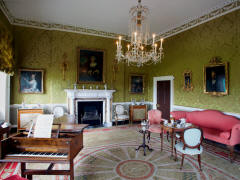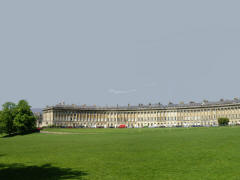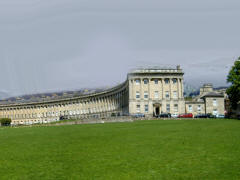|
Page 1 2 3 4 5 6 7 8 9 10 11 12 13 14 15 16 ENGLAND: LONDON
AND THE COTSWOLDS BATH: THE ABBEY & THE TOWN
Thursday, May 19
(cont.).
We found Lee
waiting for us in Bath Abbey
Square. He walked us perhaps
20 yards to the Abbey
entrance and said goodbye.
(There was no entrance fee.)
We could not believe that he
had driven four hours (round
trip), then waited for us
two more hours, just to show
us the entrances to the
baths and the Abbey, little
more than a block from our
hotel.
Founded in the 7th century as a monastery, Bath Abbey became an Anglican parish church in 1583. It has been rebuilt or restored several times over the years. Although the church was huge and there was much to see, after spending two hour underground in the baths we were eager to get out into the sun and see the city. We spent less than an hour in the Abbey. Coming out into the Square, we decided to explore Union Passage, narrower than most of the streets leading out of the Square and more "charming." It was a good choice, but we did not have a map and had no idea where we were going. We decided to backtrack to the tourist information center by the Square. Since Sally Lunn;s restaurant, near our hotel, was right around the corner, we thought we would have a light lunch first. It was crowded and we had a little wait, but the food (pea soup and half a Sally Lunn roll) was very good. We also had a look at their "kitchen museum."
On our way back to the square, we passed the 18th Century Pump Room (restaurant) and stopped there for a look. We continued to the tourist information office. We found some useful maps and brochures and also inquired about the Jane Austin Center. We found that we had been close to it when we turned back from our walk on Union Passage.
We walked just over a block north to the Circus, a large traffic circle surrounded by big townhouses. Built between 1754 and 1768, it was one of Bath's most prestigious neighborhoods during Jane Austin's time here. Just a couple blocks down Brock Street is the even more prestigious Royal Crescent (1767-1774), consisting of 30 large townhouses. One of them, No. 1 Royal Crescent, has been restored and furnished to reflect life in the 18th century. It just opened to the public in 2013. We spent more than an hour going through it. It started raining just as we went in and continued for most of our visit. The sun was out when we emerged. We walked south through the a park-like area. We had a great view of the entire Crescent as we looked back. On the way back we went through Victoria Park where Jane managed to find her afternoon Magnum bar. It was about 17:15 so we headed back to our hotel. We rested for a while before going out to dinner at 19:15. We thought about going back to the Joya but, since we had done quite a bit of walking, we opted for Tilly's Bistro, just a few steps away next to the Sally Lunn. The food was great and the service, too. Best of all, it was quiet.
|




